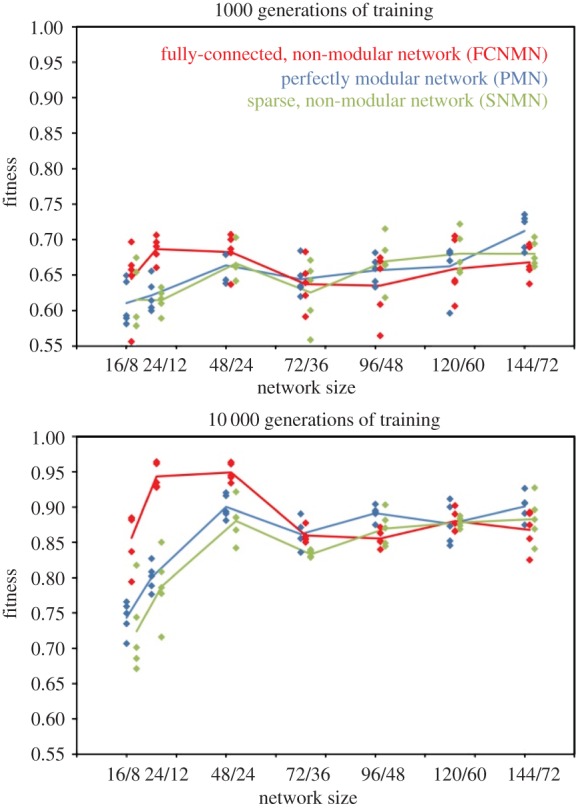Proc. R. Soc. B 282, 20142568 (2015; Published online 28 January 2015) (doi:10.1098/rspb.2014.2568)
The purpose of this short article is to detail an error in the data represented in fig. 7 of [1]. In error, a constant value of connective density rather than a relative value was used in models across most of the network size range in the SNMN networks shown as green in figure 7. The unusual dynamics shown by green line in figure 7 is a consequence of this coding error and the correct line is similar to that of the blue PMN networks. A corrected figure 7 is included here.
Figure 7.

Networks conformed as networks in state 1 (figure 6) with simulations run on networks of different size with a smaller number of replicates at each size. Diamonds are raw fitness values for each simulation run and lines join means of these points. The ratios on the horizontal axis refer to the number of nodes in the input and hidden layers, respectively. All networks had a single output node. Networks of each type (red, blue and green) are offset on the horizontal axis by 0.2 to allow visualization of points. (Online version in colour.)
This parameter is correctly scaled in all data within figs. 1–6 of [1] in which only network sizes of 16 × 8 × 1 and 96 × 48 × 1 are considered: the probability of connection between nodes in the input and hidden layers is 0.5 in the 16 × 8 × 1 network and 0.083 in the 96 × 48 × 1 network. The error does not, therefore, affect the main results or conclusions of the paper (that the relative benefits of modularity are quite different in small and large networks). We refer to the artefactual dynamic in a few places in the manuscript, namely: lines 10–14 of the abstract; the last paragraph of the results section and paragraph two of the discussion. Essentially, arguments made in the paper to the effect that modularity may also be favoured in smaller networks when connective density must be kept low (the second paragraph of our discussion) are invalid.
The responsibility for this error is principally with C.R.T. as he was responsible for writing and debugging code used to produce this output.
Reference
- 1.Tosh CR, McNally L. 2015. The relative efficiency of modular and non-modular networks of different size. Proc. R. Soc. B 282, 20142568 ( 10.1098/rspb.2014.2568) [DOI] [PMC free article] [PubMed] [Google Scholar]


